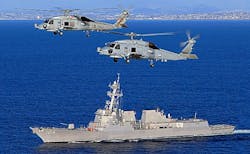Lockheed Martin to begin installing electronic warfare (EW) avionics aboard Navy helicopters
Officials of the Naval Air Systems Command at Patuxent River Naval Air Station, Md., announced a $20 million contract Thursday to the Lockheed Martin Rotary and Mission Systems segment in Owego, N.Y., to integrate the Advanced Off-Board Electronic Warfare (AOEW) avionics aboard the two Navy helicopter variants.
The AOEW is a helicopter-based long-range EW system to counter existing and future enemy anti-ship missiles. AOEW will provide long-endurance, off-board electronic countermeasures against current and future anti-ship missile threats with a long-duration EW active mission payload for the MH-60R and MH-60S helicopters. Lockheed Martin officials announced their company's contract win to develop the AOEW system earlier this month. The overall AOEW program, which is under direction of the Naval Sea Systems Command in Washington, began in 2014.
Lockheed Martin’s AN/ALQ-248 AOEW Active Mission Payload (AMP) is a pod hosted on the MH-60R or MH-60S helicopters to enhance the way the U.S. Navy detects and responds to anti-ship missile threats.
The AOEW program intended to devise countermeasures for some of the world's most advanced radar-guided anti-ship missiles, such as the Russian-made SS-N-22 Sunburn and SS-NX-26 Oniks.
The Sunburn can fly at three times the speed of sound and carries a 705-pound explosive warhead. The Oniks missile, meanwhile, can fly as fast as Mach 2.5, carries a 661-pound warhead, and may have the capability to maneuver on its terminal flight to its target, which could make defeating it difficult, if not impossible.
One of the goals of the AOEW program is to detect and jam incoming fast anti-ship missiles at standoff ranges to give on-board and off-board missile defenses a fighting chance at staving off the incoming weapon.
Although initial AOEW prototypes are to be installed on MH-60R and MH-60S helicopters, future deployable versions may be intended for long-range, long-endurance fixed-wing or helicopter unmanned aerial vehicles (UAVs), experts say.
The AOEW system will feature a modular open-systems architecture (MOSA) to enable the EW payload to adapt to evolving threats, hasten deployment, reduce development time and costs, and facilitate future system upgrades and technology insertion. For more information contact Lockheed Martin Rotary and Mission Systems online at www.lockheedmartin.com/us/rms.html, or Naval Air Systems Command at www.navair.navy.mil.
Learn more: search the Aerospace & Defense Buyer's Guide for companies, new products, press releases, and videos

